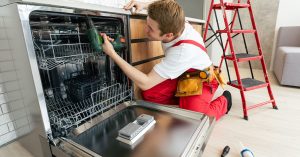At JAY Appliances, we believe that lasting appliance performance depends on one key factor: consistent quality during every repair. When clear service standards guide how work is done, results stay reliable no matter who performs the task. We’ve seen how this consistency builds trust, reduces callbacks, and extends the life of home appliances. Understanding what defines strong service standards can help every homeowner recognize quality work from the start.
Setting Clear Service Standards Builds Trust
Every professional repair begins with a defined process. Standards ensure that no step is skipped, from diagnosis to final testing. When a technician follows proven methods, outcomes remain predictable. Over time, that predictability becomes trust. We notice that clear guidelines also make communication smoother between our team and homeowners.
However, standards go beyond checklists. They reflect values like honesty, respect, and accountability. When we commit to doing the job the same careful way each time, we show that our goal is dependable performance, not shortcuts. If you ever search for appliance repair in St Albert, looking for a company that prioritizes process over speed often leads to better long-term results.
Consistent Inspections Prevent Repeated Failures
Before any part is replaced, the root cause must be clear. Strong service standards require full inspection, not guesswork. When we inspect thoroughly, we prevent the same issue from reappearing weeks later. This detailed approach may take slightly longer upfront, but it saves both time and frustration in the long run.
Standards also define how results are verified. A simple test run after repair ensures that everything operates under normal conditions. Many breakdowns occur because small errors go unchecked. Reliable technicians test beyond basic function, checking temperature accuracy, drainage, and load balance depending on the appliance type. This routine makes every repair stronger and safer for daily use.
Communication Is a Core Part of Quality Service
We’ve learned that a successful repair involves more than just tools and parts. Clear communication sets the tone for consistent quality. Explaining what happened, why it happened, and how to prevent it helps homeowners feel in control of their appliances again. That open exchange builds confidence and encourages preventive care.
Detailed communication also allows us to document findings accurately. Good records make future repairs easier and faster. They reduce the chance of repeated misdiagnosis, especially in homes with multiple appliances of the same brand or age. Consistency in communication means every technician can continue the same level of care seamlessly if future visits are needed.
Training and Skill Development Keep Standards Strong
Even the best standards fail without proper training. Every technician must understand not only what to do but why each step matters. We’ve found that hands-on practice and ongoing education keep our team adaptable to new technology and appliance models. When knowledge stays current, mistakes drop dramatically.
Modern appliances evolve quickly, with smart features and complex sensors. Without training, small errors can lead to costly damage. Continuous learning ensures that repairs meet manufacturer expectations and maintain safety compliance. More importantly, it helps technicians notice early warning signs that might not appear obvious. These insights protect both the appliance and the customer’s investment.
Using the Right Tools and Parts Defines Reliability
A technician’s results are only as good as their tools and materials. Consistent repair quality depends on using precise instruments and approved parts. We’ve seen many issues caused by poorly fitted replacements or incompatible components. Quality standards eliminate that risk by specifying exactly what materials meet performance needs.
When we choose genuine or equivalent-grade parts, repairs last longer. It’s not just about replacement; it’s about balance. Matching resistance, voltage, or water flow to the original design ensures that the appliance functions as intended. That consistency directly affects efficiency, noise level, and safety, all of which define lasting quality.
Documentation Keeps Performance Transparent
Reliable service standards always include recordkeeping. Every inspection, test result, and repair note contributes to a clear maintenance history. This transparency benefits both technicians and homeowners. For us, it ensures that no information is lost between visits. For homeowners, it provides proof of proper maintenance that supports warranty claims or resale value.
Proper documentation also highlights recurring problems. Patterns like frequent heating element failures or unusual vibrations can point to deeper electrical or installation issues. When this data is reviewed over time, it prevents wasted effort and unnecessary costs. Documentation might seem administrative, but it is one of the most powerful tools for ensuring repair consistency.
Accountability Ensures Every Repair Meets Expectations
Accountability is built into every step of a service standard. Each technician must verify their work through a checklist before finishing. These internal controls guarantee that no detail is missed. We also see accountability as a form of respect toward the customer’s home. Following procedure keeps both people and property safe.
Strong accountability doesn’t mean rigid behavior. It means recognizing when an unexpected issue requires attention beyond the initial scope. For example, spotting a frayed wire during a dryer repair isn’t just helpful—it’s part of doing the job properly. This awareness defines the difference between quick fixes and reliable service that genuinely prevents future breakdowns.
Safety Standards Protect Everyone Involved
Appliance repair involves electrical, thermal, and mechanical risks. Consistent safety standards minimize these risks for both customers and technicians. We always start by confirming that power is properly disconnected before any inspection. Proper grounding, correct circuit load, and ventilation checks follow naturally.
Adhering to safety practices also keeps appliances compliant with national standards. Neglecting them can lead to hazards or insurance issues later. When every technician understands that safety isn’t optional, quality automatically improves. Safe procedures create cleaner, more professional results and reinforce confidence in every completed job.
Customer Feedback Shapes Stronger Standards
We see every service visit as an opportunity to learn. Customer feedback reveals where standards can improve. Sometimes it’s about communication clarity, sometimes about timing. Listening helps us refine expectations and eliminate weak points. Over time, that cycle of listening and improving creates reliability customers can sense immediately.
Feedback also highlights when old procedures no longer match modern needs. For instance, the shift toward energy-efficient models introduced new diagnostic requirements. Without customer input, that transition could have gone unnoticed. When homeowners share experiences, they indirectly help improve service for everyone. Consistency grows stronger through shared accountability.
Timeliness Completes the Circle of Quality
Even perfect repairs lose value if they’re delayed unnecessarily. Service standards must include response time and scheduling reliability. We treat time as a resource, not a convenience. Keeping appointments on schedule and arriving prepared prevents both frustration and prolonged downtime for essential appliances.
Timeliness also affects repair success. Some appliance issues worsen if left unresolved too long, such as leaks that cause corrosion or electrical shorts. When teams commit to quick yet careful service, long-term reliability increases. It’s the balance of precision and speed that defines professional responsibility.
Continuous Evaluation Keeps Quality Measurable
Service standards cannot stay static. Continuous evaluation ensures they evolve with new technologies and real-world challenges. Regular audits, peer reviews, and post-repair checks keep everyone aligned. We’ve learned that even small updates, such as adjusting torque specifications or revising test sequences, can greatly improve consistency.
By measuring performance against clear benchmarks, we can identify which methods deliver the best results. That analysis leads to ongoing improvement. When every technician understands that excellence is measurable, pride in workmanship naturally follows. Continuous evaluation keeps both skill and motivation strong across every level of service.
The Role of Ethics in Consistent Repair Practices
Ethical responsibility anchors all other standards. Trust grows when technicians make decisions in the customer’s best interest. Replacing a part unnecessarily may generate short-term gain, but it erodes long-term confidence. Ethical repair means diagnosing honestly and recommending only what the appliance truly needs.
When ethics guide decision-making, consistency becomes effortless. Every customer receives equal honesty and effort regardless of appliance type or repair size. This reliability strengthens relationships and creates a reputation for dependability. Ethics transform service from a transaction into a professional partnership built on respect.
Encouraging Preventive Habits Extends the Benefits
High service standards shouldn’t end after the repair. Sharing maintenance advice helps homeowners prevent future issues and maintain efficiency. Small reminders—like cleaning lint filters, defrosting freezers, or checking door seals—make a big difference. We’ve seen that consistent follow-up builds awareness that keeps appliances running smoothly.
Preventive guidance also reduces unnecessary service calls. When customers understand proper care, repairs focus on genuine issues rather than avoidable wear. A good technician aims to make every visit both corrective and educational. This balance supports reliability across all future maintenance efforts.
When to Seek Professional Help
Sometimes an appliance issue seems minor, but delaying can cause bigger damage. If your washer shakes violently, your oven heats unevenly, or your fridge cycles too often, those are early warning signs. Waiting until a complete failure can mean higher costs later.
Reaching out for help at the first sign of trouble ensures safe and accurate fixes. When you need experienced technicians who follow reliable standards for appliance repair in St Albert, look for teams that prioritize detailed diagnosis, consistent methods, and transparent communication. You can always contact us for advice or scheduling support to restore safe and steady appliance performance.
FAQs
1. What defines a high-quality appliance repair?
A high-quality repair follows consistent procedures from diagnosis to testing. It uses compatible parts, maintains safety compliance, and restores the appliance’s designed performance without cutting corners.
2. How often should service standards be reviewed?
Service standards should be evaluated regularly, at least once a year. Frequent reviews ensure that technicians stay current with new appliance technology and safety practices.
3. Why is documentation important in repair work?
Documentation keeps service history organized. It helps identify recurring problems, ensures warranty compliance, and allows future technicians to continue repairs with accurate background information.
4. Can customer feedback really improve repair standards?
Yes. Feedback helps identify weak points in communication, scheduling, or procedure. When applied correctly, it strengthens service reliability across all future visits.
5. What should homeowners do between professional visits?
Homeowners should clean filters, inspect seals, and monitor unusual noises or performance changes. Small preventive habits help maintain efficiency and reduce the need for urgent repairs.



